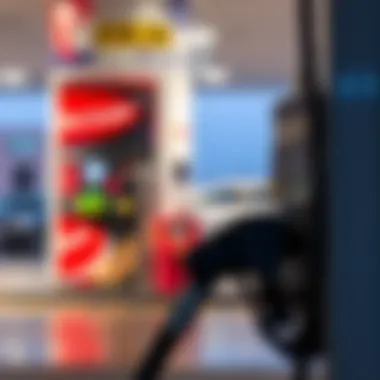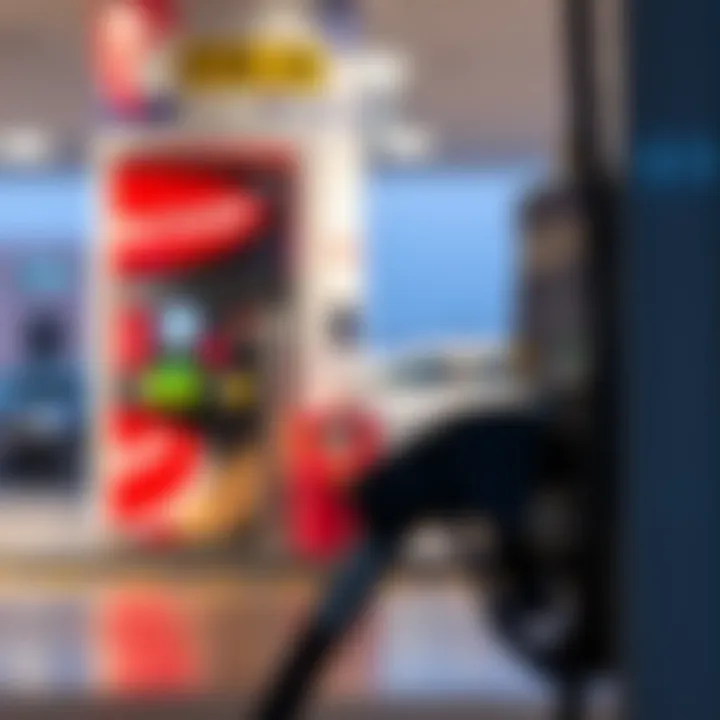Understanding Gasoline Prices in the UAE Explained


Intro
The price of gasoline in the UAE is not just a matter of filling up a tank; it's a reflection of broader economic currents that sway consumer behavior, real estate investments, and even government policies. Understanding why prices fluctuate and the factors that influence them is crucial for various stakeholders—investors, buyers, agents, developers, and expatriates alike.
In this guide, we’ll take a comprehensive look at the complexities of gasoline pricing in the UAE. From current trends and price analysis to how these prices impact real estate, our exploration will lend insights essential for anyone involved in or planning to enter the UAE market.
As we navigate through this analysis, it becomes evident that the discussions surrounding gasoline prices extend far beyond the pump. They delve into economic dynamics, such as supply and demand, international oil prices, and government subsidies, all intertwined with the fabric of the UAE's energy landscape.
By comprehensively understanding these elements, readers will glean not just the ‘how’ of price changes, but also the ‘why’ behind these shifts, enabling informed decision-making in their respective endeavors.
Whether you are considering buying property in Dubai or evaluating fuel expenses for business operations, the effects of gasoline prices resonate throughout.
Let’s delve into the details.
Market Insights
Current Trends
In recent years, gasoline prices in the UAE have shown volatility, influenced by both local and global market conditions. The introduction of a liberalized pricing regime in 2015 meant that prices are now more reflective of the international oil market, unlike in the past when government subsidies kept them artificially low.
As of now, prices have seen an upward trend partly due to fluctuations in crude oil prices. Increases in demand from emerging markets and geopolitical tensions often cause abrupt price hikes. Understanding these external pressures gives buyers a clear picture of what to expect for their fueling costs moving forward.
Price Analysis
From a comparative perspective, gasoline prices in the UAE remain competitive, particularly when aligned with global norms. Despite the rising costs, the nation still enjoys some of the lowest gasoline prices compared to Western standards. The pricing structure is also influenced by transportation costs and distribution logistics.
"Prices at the pump can vary significantly within the UAE itself due to regional distribution channels and local demand fluctuations."
This highlights the need for consumers to be conscious of where they fuel their vehicles—some areas may offer better deals than others.
As we analyze these dynamics, it is essential to look at the real estate implications next.
Investment Strategies
Buying vs. Renting
In light of fluctuating gasoline prices, potential investors must weigh their options carefully. For those leaning towards buying a property, especially in areas like Dubai, it’s crucial to consider the added costs associated with commuting. If prices soar, those costs can infiltrate monthly budgets rapidly.
On the other hand, renting can be an attractive short-term strategy, especially during periods of unstable pricing.
Financing Options
When it comes to financing real estate deals, buyers need to keep gasoline expenses in mind. Rising transportation costs can affect overall affordability, urging lenders to consider long-term implications on borrowers’ debt-to-income ratios. Prospective homeowners should explore a range of financing options to mitigate risks associated with fuel price volatility.
In summary, comprehending the intricacies of gasoline pricing in the UAE fuels better decision-making in real estate and investment strategies. The integration of these insights into daily financial planning can mean the difference between thriving and merely surviving in a dynamic market environment.
Overview of Gasoline Prices in the UAE
Understanding gasoline prices in the UAE is crucial not only for residents but also for investors, expatriates, and anyone who relies on fuel for transportation. The UAE, being one of the largest oil producers in the world, has its unique pricing structure influenced by a web of global and local factors. This overview sets the stage for a deeper exploration of prices, trends, and the implications they hold for various stakeholders.
Current Price Per Liter
Currently, as of the latest figures, the price per liter of gasoline fluctuates based on a variety of factors. It's good to keep in mind that prices can also change every month due to government regulations. For instance, in September 2023, the price was approximately AED 3.05 for Super 98 octane fuel, while Special 95 was around AED 2.93 and E-Plus 91 hovered at AED 2.76. These numbers illustrate how even within the UAE, the price varies according to the fuel type, reflecting different operational and refinement processes.
However, pricing isn't carve in stone; fluctuations in global oil prices and local demand contribute significantly to how much consumers pay at the pump. Understanding these current pricing schemes is essential for budget-conscious drivers and savy investors who are navigating the ever-evolving landscape of fuel costs.


Historical Price Trends
Diving into the historical trends, gasoline pricing in the UAE has undergone notable changes over the past decade. In 2015, the government removed fuel subsidies, resulting in a dramatic increase in gasoline prices. For example, the price of Super 98 skyrocketed from around AED 1.72 per liter just before the subsidy removal to a peak of AED 3.10 in 2018. This shift marked a transition towards market-driven pricing.
As we look back, we can identify cycles of price adjustments that reflect broader economic factors such as OPEC’s production decisions and geopolitical events. Prices dropped again globally due to the pandemic in 2020, and local prices mirrored this trend, providing some relief to motorists during a challenging year. In recent times, prices have stabilized, but they remain influenced by both international oil markets and local policy, making it essential to keep an eye on historical data for forecasting future trends.
The fluctuation of gasoline prices is not just a matter of local concern; it ties directly into the global oil supply chain, which is influenced by social, political, and environmental factors.
Factors Influencing Gasoline Prices
Understanding the dynamics behind gasoline prices in the UAE is crucial not just for consumers but also for investors, home buyers, and real estate agents. Without grasping how various elements play a role in pricing, stakeholders might misinterpret trends or make decisions that could be financially detrimental. Let’s break down the main factors influencing these prices, providing clarity for anyone navigating this complex landscape.
Global Oil Prices
Globally, oil prices act like the pulse of the gasoline sector. When global oil prices rise, we can generally expect a corresponding jump in gasoline prices. The connection here isn't just coincidental; it's woven into the fabric of the oil industry. For instance, geopolitical events, OPEC decisions, and market speculations can send shocks to oil prices. So when tensions flare in oil-rich regions like the Middle East, it often results in price increases at the pump in the UAE.
To illustrate, imagine a sudden unrest in a country pivotal to oil supply. Buyers across the board would rush to secure oil contracts, causing prices to skyrocket. Subsequently, gas stations feel the pinch and adjust their prices accordingly, impacting everything from individual budgets to broader economic conditions.
"As global markets fluctuate, local gas prices in the UAE don’t just reflect costs—they narrate economic stories."
Local Production and Refinement Costs
Locally produced oil and the costs associated with refining it are major players in determining gasoline prices in the UAE. While the country is rich in natural resources, the actual extraction and processing incur expenses that inevitably reflect on consumer prices.
When we look at local production, one must consider the complexities of extracting crude oil, transporting it to refinery facilities, and converting it into finished gasoline. Each step of this process involves labor, technology, and materials that contribute to overall costs. A significant pump in the local labor market wages, for example, may prompt a rise in gas prices to cover these additional expenses.
Moreover, the refining aspect is not straightforward. Fluctuations in operational efficiency, maintenance downtime, or even technological upgrades can lead to variations in production costs. Therefore, any rise in local production costs can ripple through to the consumers.
Government Regulations and Subsidies
The UAE government plays a pivotal role in shaping gasoline prices through regulations and subsidies. While the country has enjoyed subsidized fuel prices for decades, recent policy changes have introduced a new layer of complexity.
When the government decides to adjust subsidies, it can lead to unexpected price shifts for consumers. If subsidies are reduced, gas prices often increase, thereby impacting daily budgets for many residents. On the flip side, maintaining higher subsidies can reduce the fiscal burden on individuals but may place pressure on government budgets.
Understanding these regulations and their implications is not just a matter of economics; it's about being aware of how policy changes could impact personal finances. Investors or buyers looking at the real estate market should also keep an eye on these trends, as any significant adjustments can reverberate through local economies and subsequently influence property values.
In summary, understanding how global oil prices, local production costs, and government policymaking intertwine to influence gasoline prices provides invaluable insight not only for consumers but also for investors seeking to make informed choices in their market dealings.
Comparative Analysis with Other Countries
When we look at gasoline prices, it is crucial to not just consider what consumers pay at the pump in the UAE, but also how these prices stack up against those in other countries. This comparative analysis serves several important purposes. Firstly, it provides a broader context for understanding local pricing dynamics. By seeing how fuel prices fluctuate in tandem with global and regional trends, individuals can better grasp the implications for both personal budgeting and larger economic factors.
Moreover, this analysis can inform investment decisions, particularly for those involved in real estate and other sectors that may be sensitive to fuel cost fluctuations. When gasoline prices in a region are significantly lower or higher than in neighboring countries, it can affect demand for real estate and consumer goods, thereby influencing market stability.
Gasoline Prices in the Gulf Region
In the Gulf region, gasoline prices exhibit a spectrum that is heavily influenced by local oil production capabilities, governmental policies, and market conditions. For instance, countries like Saudi Arabia and Kuwait tend to offer substantially lower fuel prices compared to the UAE. Prices often hover around a dollar or even less per liter in these nations, supported by extensive subsidies. In contrast, the UAE has introduced a pricing mechanism that reflects more closely the fluctuations in global oil prices.
- Saudi Arabia: Prices are often subsidized, resulting in some of the lowest prices for consumers.
- Kuwait: Similarly enjoys low gasoline rates, making it an attractive destination for cheap fuel.
- Oman: Generally has higher prices than its neighbors but lower than the UAE.
This regional analysis highlights not just the differences, but also the interconnected nature of these markets. A rise in global oil prices will typically push prices higher across the board, but the extent to which each country absorbs those costs varies, revealing distinct economic strategies and priorities.
Global Comparisons: Gasoline Pricing
On a global scale, gasoline prices can showcase stark differences based on various criteria including taxation, resource availability, and governmental regulations. Countries like Norway and the Netherlands boast some of the highest fuel prices, primarily due to high taxation designed to promote sustainability and reduce reliance on fossil fuels. In contrast, the United States sees a wide variance in fuel prices, influenced by state tax regulations and local supply chains.
Notable Insights:


- Countries with high gasoline prices often invest heavily in public transportation, which can reduce the necessity for low fuel costs.
- Venezuela, despite its vast oil reserves, has some of the cheapest gas prices in the world but suffers from issues related to supply and infrastructure.
- Japan’s fuel pricing is predominantly influenced by its lack of domestic oil resources, showcasing how availability plays a critical role in cost.
By examining these global trends, it becomes evident that while gasoline pricing in the UAE is competitive, it is impacted by numerous external factors and internal policy decisions. As such, understanding these dynamics serves as a helpful tool for investors, consumers, and policymakers alike in navigating the complexities of fuel pricing in the modern world.
Implications for Consumers
Understanding gasoline prices in the UAE is not just a matter of budgeting monthly expenses; it impacts nearly every facet of a consumer's life. As fuel prices fluctuate, so too do the costs associated with transportation, influencing wider economic behaviors and lifestyle choices. For investors, homeowners, and expatriates alike, keeping abreast of these trends is crucial, not merely for saving a dirham here and there but for making informed decisions in a rapidly evolving market.
Budgeting for Fuel Costs
Budgeting effectively for fuel costs in the UAE requires awareness of various factors affecting gasoline prices. Understanding how the price per liter can change week to week, or even day to day, is essential.
- Monthly Fuel Consumption: It helps to estimate how much fuel is needed based on daily commuting habits. For instance, someone commuting from Sharjah to Dubai might need to recalibrate their monthly budget just due to the varying gas prices.
- Rising Costs: With steady growth in demand and occasional fluctuations in supply—such as OPEC's decisions—fuel prices can see sharp spikes. This means that sticking to a fixed budget for fuel could lead to unexpected shortfalls, especially during peak travel seasons.
- Location Factors: Buying gas from specific petrol stations might often be more expensive or more economical, depending on promotions or loyalty programs. For example, some stations may offer a discount for members or special pricing during certain hours.
Staying informed about fuel prices through apps or websites that track changes in real time can save money in the long run. Setting aside a small buffer in one’s monthly budget may also help to shield against sudden price hikes.
Impact on Daily Commutes
Gas prices can have a tangible impact on daily routines and geographical choices. Higher gasoline prices might compel consumers to rethink their travel patterns, potentially leading to shifts in public transportation usage or even carpooling efforts.
- Public Transport Incentives: For individuals relying mostly on their cars, the urge to use public transport could increase significantly. Cities like Dubai have invested substantially in tram and metro systems, which might become the more attractive option when fuel costs rise.
- Choosing Locations: When looking for residence or office locations, consumers might begin gravitating towards areas that are transit-friendly as opposed to distant residential zones. Living closer to work not only decreases the time spent commuting but also saves on fuel.
- Environmental Awareness: Increasing fuel prices may also lead to heightened awareness of environmental issues. Choosing to drive less or opting for more fuel-efficient vehicles can become more popular as consumers weigh the costs against their personal and communal impact on the environment.
In the long run, these shifts may influence not just individual lifestyles but urban development trends as well, sparking innovative solutions in transportation, fostering a new outlook on city planning, and pushing for effective sustainability initiatives.
Informed consumers can adapt, ensuring their budget remains intact in fluctuating economic climates.
For deeper insight into how fuel prices interlink with other market forces, resources like Wikipedia or Britannica can provide more comprehensive information.
Economic Outlook and Energy Policy
Understanding the economic outlook and energy policy in the UAE is pivotal for anyone looking into gasoline prices and their implications on the broader market. This section investigates how these elements play a crucial role in shaping consumer behaviors, influencing investment decisions, and forecasting future trends.
The UAE is rich in oil reserves, but that doesn’t mean the story ends there. The government's approach to energy policy has a profound impact on how gasoline prices are formed. Recent years have seen shifts towards deregulation, which, while fostering competition, has also led to fluctuating fuel prices. This is especially relevant for investors and expatriates who must navigate these changes while making decisions about their financial commitments in the region.
As the global energy landscape continues to evolve, the UAE's strategic investments in infrastructure and technology become paramount. How Saudi Arabia and other regional players respond, in concert with global trends, can redefine expectations for fuel prices. An example of this can be seen in the rise of renewable energy initiatives which also play a role in long-term pricing strategies.
Future Trends in Gasoline Pricing
Looking ahead, several factors are likely to shape gasoline pricing in the UAE. Awareness of these trends can provide valuable insight for potential buyers and investors.
- Volatility of Global Oil Prices: The impact of geopolitics on oil supply can’t be understated. Any conflict or economic changes in oil-producing nations can trigger price fluctuations.
- Consumer Behavior Shifts: As awareness of climate change increases, a greater number of consumers may gravitate toward fuel-efficient vehicles or electric options. This could lead to a gradual decline in overall gasoline demand.
- Technological Advancements: Innovations in refining and extraction technologies might create efficiencies that can lower production costs and thus increase profit margins for companies.
Investors should pay close attention to these trends. The interconnectedness of global economies means that a sharp focus on any one of these aspects can influence overall market outcomes.
Sustainability and Renewable Energy Initiatives
There’s no denying that sustainability is becoming a cornerstone of energy discussions. The UAE has made significant strides towards integrating renewable energy into its energy portfolio, with initiatives aimed at diversifying sources beyond traditional fossil fuels. This shift has implications for gasoline prices.
- Government Initiatives: Projects like the Mohammed bin Rashid Al Maktoum Solar Park exemplify the government’s commitment to renewable energy. Such endeavors are not just environmentally friendly; they could also reshape how gasoline pricing works in the long term.
- Investment in Infrastructure: The establishment of electric vehicle (EV) charging stations across the UAE’s metropolitan areas indicates a move towards carbon neutrality. Future gasoline demand might decline as EV popularity rises.
- Public Awareness and Engagement: Knowledge initiatives aiming to educate citizens on the benefits of renewable energy can lead to an increase in adoption rates, which could ultimately stabilize or lower gasoline prices.
It’s crucial to recognize that as the UAE transitions towards cleaner energy, gasoline pricing dynamics will experience a tether to these developments.
While the immediate effect on fuel prices may not be drastic, a gradual shift underpinned by substantial government policy adaption indicates a long-term rethinking of energy consumption. For investors, this growing focus on sustainability might mean considering properties or developments in areas that align with or take advantage of these upcoming trends.
Gasoline Prices and the Real Estate Market
Understanding the interplay between gasoline prices and the real estate market forms a crucial thread in comprehending how fuel costs influence various economic facets in the UAE. Property investments are often guided not just by intrinsic value but also by external factors like transportation expenses driven by gasoline pricing. As fuel prices fluctuate, they subtly shift the dynamics of location desirability, property valuations, and even construction costs.


Influence on Property Value
The first thing to consider is the direct impact of gasoline prices on property values. When fuel costs soar, buyers tend to gravitate towards areas that offer convenience—places where public transport is easily accessible, or homes are located closer to workplaces. As a result, properties situated farther away from essential services may experience a decline in appeal, thereby pushing their values downward.
Conversely, if gasoline prices are low, buyers might be more inclined to consider suburban properties, where space is often abundant, and the ambiance is quieter compared to urban centers. This can create a ripple effect in pricing, as suburban areas gain interest, driving up the value of these properties. For instance, if we look at Dubai's outer districts like International City or Dubai Investments Park, many investors have sought these locations for their relatively lower property prices combined with spacious living conditions.
Location Preferences and Transportation Costs
When evaluating the relationship between gasoline prices and location preferences, it becomes evident that transportation costs are a significant factor. Higher fuel prices means greater expenses for commuting, leading many potential buyers to meticulously assess their daily travel requirements.
Considerations include:
- Proximity to Work: Buyers are often willing to pay more for homes located near their workplace to avoid long commutes costs. This rings especially true in a bustling metropolitan environment like Dubai, where traffic congestion can lead to frustrating delays.
- Public Transportation Access: Areas well-served by public transportation are increasingly seen as desirable, as they promise reduced dependence on personal vehicles and thus lower commuting costs during times of high fuel prices. For example, areas around the Dubai Metro and popular tram lines usually see heightened interest.
- Lifestyle Choices: Potential homeowners often factor in lifestyle when considering transportation costs related to gasoline. With a growing focus on sustainability, many are opting for electric vehicles or considering homes within cycling or walking distance of shops and social amenities.
In summary, as gasoline prices shift, so do buyer preferences and property values, impacting the real estate market in notable ways. Recognizing these nuances can offer investors critical insights into effective property acquisition strategies.
"In real estate, understanding the broader economic picture is as important as knowing the market trends."
For further insights and research data, refer to resources such as Wikipedia and Britannica.
Consumer Awareness and Information Sources
In an era where information shapes decision-making, understanding gasoline prices in the UAE takes on a notable emphasis. Consumer awareness is not merely a benefit; it's a necessity for those navigating the world of fuel pricing. When individuals possess adequate information about fuel costs, quality, and available options, it significantly influences their purchasing behavior and budgeting decisions. A well-informed consumer not only mitigates the risk of falling prey to price fluctuations but also shapes the market dynamics through collective demand.
Tracking Fuel Prices
Tracking gasoline prices is akin to keeping a finger on the pulse of the UAE's economic landscape. Fuel costs can vary dramatically from one week to the next. Therefore, it's crucial for consumers to stay vigilant. Various platforms provide real-time updates on gasoline prices across different emirates, making it easier to find the best deal. Some popular sources include:
- UAE Government Websites: These sites often publish official statistics and updates on price changes based on global oil trends.
- Fuel Apps: Several mobile applications like the E-Services app help drivers track current gasoline prices near them, assisting in smart fuel purchasing.
- Local News Outlets: Newspapers and news websites frequently report on significant shifts in fuel prices and the reasons behind those changes.
By using these resources, consumers can aid in their budgeting and ensure they are purchasing fuel at competitive rates without the inherent guesswork.
Understanding Fuel Quality and Octane Ratings
Consumers often overlook the quality of gasoline they're purchasing, focusing solely on price. However, understanding fuel quality and octane ratings is essential for several reasons. Different vehicles perform optimally with specific octane ratings, and using the wrong type can lead to decreased performance and potential engine damage. Here's a quick breakdown:
- Regular Gasoline (91 Octane): Most vehicles can operate efficiently with this grade; it's economical and provides adequate performance for everyday driving.
- Super Gasoline (95 Octane): This type offers higher performance and is typically recommended for sports cars or high-performance vehicles.
- Premium Gasoline (98 Octane): Ideal for luxury or performance-centric vehicles requiring maximum efficiency.
Understanding these distinctions allows consumers to make informed choices based on their vehicle's requirements instead of just the sticker price at the pump. A vehicle’s long-term performance and maintenance can hinge on using the right fuel type, ultimately safeguarding investments and ensuring efficient operation.
"A well-informed consumer makes educated decisions that contribute to more than just their own financial well-being; they influence the broader market ecosystem."
As we move towards an era where sustainability is also intertwined with fuel consumption, being aware of the right fuel quality is more critical than ever. For detailed and up-to-date information about gasoline prices, one can visit resources such as UAE Government portal or Wikipedia.
Closure
The exploration of gasoline prices in the UAE reveals a multifaceted picture, rich with implications for various stakeholders, including investors, buyers, agents, developers, and expatriates. Understanding the dynamics influencing gasoline pricing is paramount for anyone looking to navigate the economic landscape of the region. Beyond just numbers at the pump, gasoline prices serve as an indicator of broader economic trends and can directly affect consumer behavior and real estate investments.
Summary of Key Points
To encapsulate the key elements discussed, several points stand out:
- Current Price Structure: The price per liter is shaped heavily by global oil prices, local production costs, and governmental policies. For instance, fluctuations in crude oil prices can immediately impact retail gasoline costs.
- Historical Trends: It’s crucial to recognize historical price variations to contextualize current trends. Significant price alterations often correlate with major geopolitical events or policy shifts within oil-producing nations.
- Impact on Consumers: Gasoline costs influence budgeting and daily commuting choices, which in turn can affect consumer satisfaction and lifestyle in the UAE.
- Real Estate Market Relevance: The relationship between fuel prices and property values cannot be overlooked. Higher gasoline prices can deter buyers from certain locations, while cheaper fuel could spur increased demand in suburban areas where commuting is necessary.
Final Thoughts on Future Trends
Looking ahead, several factors suggest that the landscape of gasoline prices in the UAE will continue to evolve. As sustainability becomes a central focus for governments globally, the push for renewable energy sources may reshape the dynamics of fuel consumption. Moreover, with ongoing geopolitical shifts, markets remain volatile.
Investors and buyers should pay close attention to legislative changes regarding fuel subsidies in the UAE. A shift could lead to altered pricing structures or unexpected spikes in costs. Furthermore, as electric vehicles gain popularity, traditional gasoline demand may flatten or even decline. This adaptation will require stakeholders to be proactive in understanding market signals and adjusting their strategies accordingly.
"Gas prices don't just affect your wallet; they shape the places where you choose to live, work, and thrive."
In short, keeping a finger on the pulse of gasoline pricing trends is not just about understanding costs but rather engaging with broader economic forces at play in the region.







